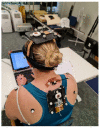Variations in Concurrent Validity of Two Independent Inertial Measurement Units Compared to Gold Standard for Upper Body Posture during Computerised Device Use
- PMID: 37571544
- PMCID: PMC10422555
- DOI: 10.3390/s23156761
Variations in Concurrent Validity of Two Independent Inertial Measurement Units Compared to Gold Standard for Upper Body Posture during Computerised Device Use
Abstract
Inertial measurement units (IMUs) may provide an objective method for measuring posture during computer use, but research is needed to validate IMUs' accuracy. We examine the concurrent validity of two different IMU systems in measuring three-dimensional (3D) upper body posture relative to a motion capture system (Mocap) as a potential device to assess postures outside a laboratory environment. We used 3D Mocap and two IMU systems (Wi-Fi and Bluetooth) to capture the upper body posture of twenty-six individuals during three physical computer working conditions (monitor correct, monitor raised, and laptop). Coefficient of determination (R2) and root-mean-square error (RMSE) compared IMUs to Mocap. Head/neck segment [HN], upper trunk segment [UTS], and joint angle [HN-UTS] were the primary variables. Wi-Fi IMUs demonstrated high validity for HN and UTS (sagittal plane) and HN-UTS (frontal plane) for all conditions, and for HN rotation movements (both for the monitor correct and monitor raised conditions), others moderate to poor. Bluetooth IMUs for HN, and UTS (sagittal plane) for the monitor correct, laptop, and monitor raised conditions were moderate. Frontal plane movements except UTS (monitor correct and laptop) and all rotation had poor validity. Both IMU systems were affected by gyroscopic drift with sporadic data loss in Bluetooth IMUs. Wi-Fi IMUs had more acceptable accuracy when measuring upper body posture during computer use compared to Mocap, except for trunk rotations. Variation in IMU systems' performance suggests validation in the task-specific movement(s) is essential.
Keywords: computer use; inertial measurement unit; posture; upper body posture; validation; wearables.
Conflict of interest statement
The authors declare no conflict of interest.
Figures



Similar articles
-
Infant trunk posture and arm movement assessment using pressure mattress, inertial and magnetic measurement units (IMUs).J Neuroeng Rehabil. 2014 Sep 6;11:133. doi: 10.1186/1743-0003-11-133. J Neuroeng Rehabil. 2014. PMID: 25194825 Free PMC article.
-
Comparing inertial measurement units and marker-based biomechanical models during dynamic rotation of the torso.Eur J Sport Sci. 2020 Jul;20(6):767-775. doi: 10.1080/17461391.2019.1666167. Epub 2019 Sep 19. Eur J Sport Sci. 2020. PMID: 31512552
-
Knee deep in Error: Unraveling the accuracy limitations of consumer-grade wearable motion sensors with limited degrees of freedom computing knee joint angles.Comput Biol Med. 2025 Jul;193:110469. doi: 10.1016/j.compbiomed.2025.110469. Epub 2025 May 29. Comput Biol Med. 2025. PMID: 40446544
-
Concurrent validity of inertial measurement units in range of motion measurements of upper extremity: A systematic review and meta-analysis.Wearable Technol. 2024 Oct 4;5:e11. doi: 10.1017/wtc.2024.6. eCollection 2024. Wearable Technol. 2024. PMID: 39464639 Free PMC article. Review.
-
Validity and reliability of wearable inertial sensors in healthy adult walking: a systematic review and meta-analysis.J Neuroeng Rehabil. 2020 May 11;17(1):62. doi: 10.1186/s12984-020-00685-3. J Neuroeng Rehabil. 2020. PMID: 32393301 Free PMC article.
Cited by
-
Multi-Planar Cervical Motion Dataset: IMU Measurements and Goniometer.Sci Data. 2025 Jan 3;12(1):13. doi: 10.1038/s41597-024-04351-4. Sci Data. 2025. PMID: 39753563 Free PMC article.
-
Monitoring Resistance Training in Real Time with Wearable Technology: Current Applications and Future Directions.Bioengineering (Basel). 2023 Sep 14;10(9):1085. doi: 10.3390/bioengineering10091085. Bioengineering (Basel). 2023. PMID: 37760187 Free PMC article. Review.
-
Effects of nordic walking training on gait and exercise tolerance in male ischemic heart disease patients.Sci Rep. 2024 May 16;14(1):11249. doi: 10.1038/s41598-024-62109-9. Sci Rep. 2024. PMID: 38755348 Free PMC article.
References
MeSH terms
Substances
LinkOut - more resources
Full Text Sources
Medical

